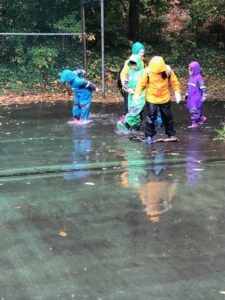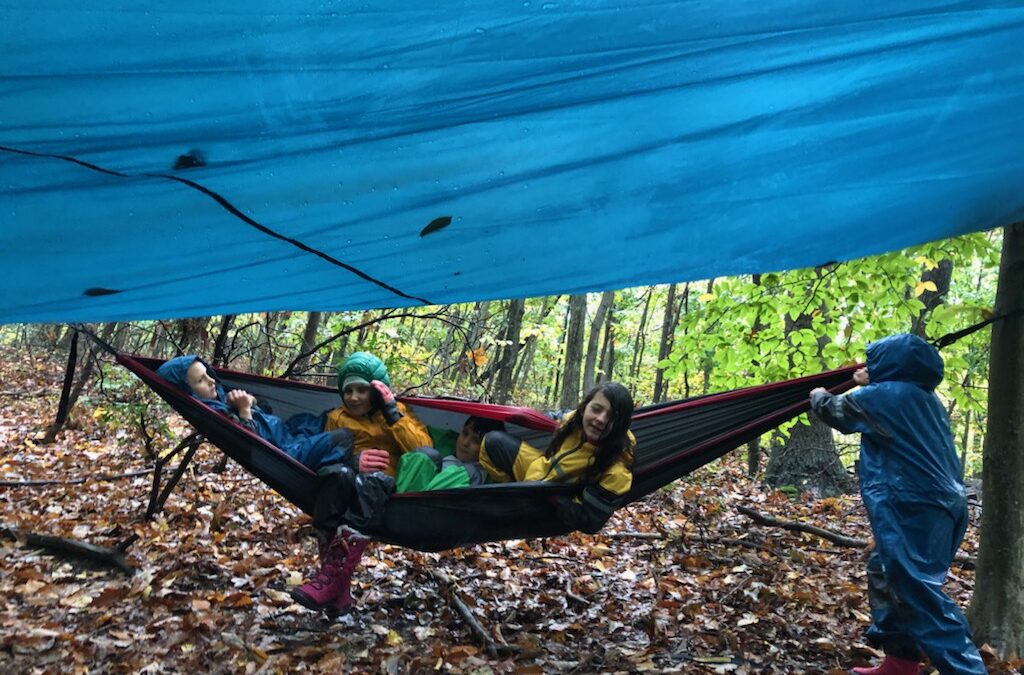Children are True Forces of Nature

“When we go outside in all weather, it teaches our children to cherish and visit Mother Nature even when she’s not “perfect”- that it’s not a conditional relationship only to be honored and respected when it meets every one of our demands and expectations.”-Nicolette Sowder of Wilder Child
Deep learning involves play and play requires safety and trust. At Forest School, where child led and self directed learning is our ethos, rather than creating a lesson plan driving the collective experience, the leaders’ role is to curate an environment where learners feel comfortable enough to play. How can we encourage our learners to be fully embodied in the present moment, led by their curiosity, inspired to explore and discover whatever lessons Nature has in store for each learner today? Rather than letting our ideas and desires about what we think they should learn (although well meaning) interfere with each individuals’ process, we trust in the collaboration between Nature and each learner. In my humble opinion, Nature is far more intelligent than our limited understanding especially when it comes to planning the lessons and timing intended for each unique souls’ path. So, we keep it simple and go back to the basics. We strip it back to where it’s real.
When it comes to safety, we ensure that our learners are as safe as necessary, not as safe as possible. In nature and in life, there are risks involved and building resilience and an understanding of our gut instincts is necessary. There are obvious hazards to consider and remove in the physical environment but there are also unseen requirements for safety that may differ from learner to learner based on their upbringing and unique life experience. Each learner requires our observation and focused attention to continuously ask both literally and symbolically, “how are you feeling” and “what do you need?” This allows for meaningful awareness and communication to flow.
We must “get very real and honest about barriers we face, children face, in feeling safe, feeling belonging, finding success etc. and acknowledge the systems that were built for some people not to succeed” – Dr Lisa Pepper-Satkin
As humans, we are regulated by our nervous system which has two main modes of operation, sympathetic (fight or flight) and parasympathetic (rest and digest). All healing occurs in the parasympathetic mode… as does the best learning. When we are able to let our defenses down and stop assessing the scene for safety, we have access to a lot more energy for learning and integration of knowledge. Our body is wired for survival and will shut down certain physiological processes that are not deemed important while under attack, which is great for survival but not suitable for learning. This is encoded in our DNA and even when we can surrender into the parasympathetic state, there is a part of us, still aware and assessing our environment for potential threats, whether physical, emotional, or otherwise. Having a mentor, that we can trust to look out for our safety can allow us to stay in this parasympathetic state and access healing, learning and pure living. This basic understanding of our design is an important one that can help guide our approach as mentors, leaders, guides, and space holders.
“We must be guardians of spaces that allow students to breathe, be curious, and to explore the world and be who they are without suffocation.“ – Brene Brown
What are some ways we can create a safe as necessary space at Forest School?
- Starting with an opening circle to set up a container for the day.
- Support sharing and validating of all emotional experiences as they arise.
- Celebrate each learner for their unique expression and reinforce that each one of us is born perfect and enough exactly as we are.
- Acknowledge and respond to requests for comfort when feelings of unsafety arise.
- Encourage all learners to consider if their needs are question if they are being met, moment to moment.
- Be available and welcoming for any and all concerns to be expressed and addressed.
- Have supplies and tools to ensure physical needs are met.
 This week at Forest School we embarked on playing in the rain. This is not new to us, our learners love to jump in puddles, play with mud, and dance in the rain. Each of our learners expressed what they liked doing in the rain and each shared a playful experience, rather than dismissing rain as a “bad day.” Our suggestion for our learners to wear Oakiwear and wellies most days, allows for these invigorating experiences to take place while maintaining comfort and safety. This wasn’t your ordinary sun shower and we learned there is a huge difference in our tolerance for rain when it’s cold and when it’s warm. We story-told under our shelter in the woods, shared experiences and discussed ways we keep warm on cold, rainy days. We ran in the rain and even made a giant slip’n slide with our tarps. Woohoo!
This week at Forest School we embarked on playing in the rain. This is not new to us, our learners love to jump in puddles, play with mud, and dance in the rain. Each of our learners expressed what they liked doing in the rain and each shared a playful experience, rather than dismissing rain as a “bad day.” Our suggestion for our learners to wear Oakiwear and wellies most days, allows for these invigorating experiences to take place while maintaining comfort and safety. This wasn’t your ordinary sun shower and we learned there is a huge difference in our tolerance for rain when it’s cold and when it’s warm. We story-told under our shelter in the woods, shared experiences and discussed ways we keep warm on cold, rainy days. We ran in the rain and even made a giant slip’n slide with our tarps. Woohoo!
Dynamic whole-body play involves full immersion into the present experience which can also illuminate any pain and discomfort alongside access to various lessons, wisdom, and joy. We must ensure that our primary foundation of “taking care of yourself” is met before any learning can occur. In my forest therapy training, we were trained to identify and expand our edges, to become aware of our own thresholds and stay within them to be able to truly be present and hold space for the group.
As the rain got more intense, most of our learners continued to play and modified their clothing and/or location to minimize discomfort, while others expressed being too cold and wanting help to find a solution. The ability to identify our own limits and ask for help is a major skill that some people lose as they get older. One learner was having a hard time and thankfully her caregiver packed some hot tea and we had a hand warmer to share. There was a limited supply of hand warmers and another learner was expressing discomfort a little less directly. I asked if she was warm enough to share with her friend, and in her own time, when her needs were met, she was then able to share the hot pack and help another. This is what it’s all about, to extend love, compassion and vulnerability after our initial comfort needs are met. This is why the Forest School Way has a sequence that starts with 1.taking care of ourselves first, then we can 2. take care of each other and only after these two are met, can we truly 3. take care of Mother Earth.
We are so grateful to be able to not only speak about ways to take care of ourselves, each other and Mama Earth but also to fully practice these guidelines in alignment with all the forces of nature.
Storytelling + Storyacting: A Powerful Tool For Children
“Storytelling is the most powerful way to put ideas into the world today.”- Robert McAfee Brown So some may wonder, why is storytelling so crucial to children’s development and how can we encourage the practice with them? “Storytelling connects your child to...
What is Friluftsliv and Can It Make Us Healthier, Happier and More Creative?
"Friluftsliv isn't something you can touch. It's something you feel in your soul."– August Casson Friluftsliv (pronounced FREE-loofts-liv) or “open-air life” is a big part of Aishling Forest School’s outdoor pedagogy and is a centuries-old Nordic tradition of...
How Forest School Nurtures Brain Development
“When we help a child to feel secure, feel appreciated, feel that “somebody is deeply, truly interested in me,” by the way we just look, the way we just listen, we influence that child’s whole personality, the way that child sees life.” – Magda Gerber It is...




